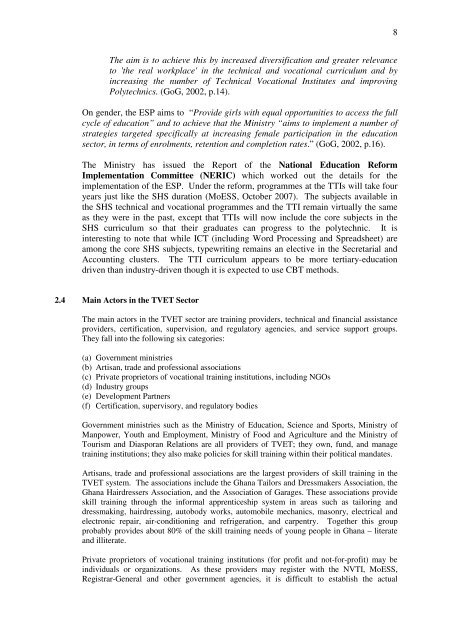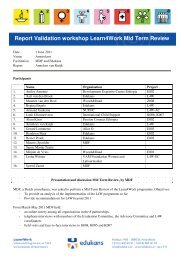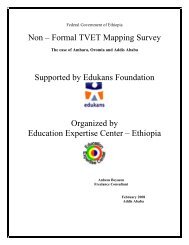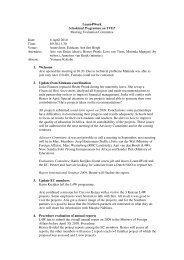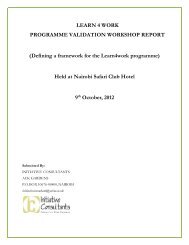DRAFT TECHNICAL AND VOCATIONAL EDUCATION AND ...
DRAFT TECHNICAL AND VOCATIONAL EDUCATION AND ...
DRAFT TECHNICAL AND VOCATIONAL EDUCATION AND ...
You also want an ePaper? Increase the reach of your titles
YUMPU automatically turns print PDFs into web optimized ePapers that Google loves.
8<br />
The aim is to achieve this by increased diversification and greater relevance<br />
to 'the real workplace' in the technical and vocational curriculum and by<br />
increasing the number of Technical Vocational Institutes and improving<br />
Polytechnics. (GoG, 2002, p.14).<br />
On gender, the ESP aims to “Provide girls with equal opportunities to access the full<br />
cycle of education” and to achieve that the Ministry “aims to implement a number of<br />
strategies targeted specifically at increasing female participation in the education<br />
sector, in terms of enrolments, retention and completion rates.” (GoG, 2002, p.16).<br />
The Ministry has issued the Report of the National Education Reform<br />
Implementation Committee (NERIC) which worked out the details for the<br />
implementation of the ESP. Under the reform, programmes at the TTIs will take four<br />
years just like the SHS duration (MoESS, October 2007). The subjects available in<br />
the SHS technical and vocational programmes and the TTI remain virtually the same<br />
as they were in the past, except that TTIs will now include the core subjects in the<br />
SHS curriculum so that their graduates can progress to the polytechnic. It is<br />
interesting to note that while ICT (including Word Processing and Spreadsheet) are<br />
among the core SHS subjects, typewriting remains an elective in the Secretarial and<br />
Accounting clusters. The TTI curriculum appears to be more tertiary-education<br />
driven than industry-driven though it is expected to use CBT methods.<br />
2.4 Main Actors in the TVET Sector<br />
The main actors in the TVET sector are training providers, technical and financial assistance<br />
providers, certification, supervision, and regulatory agencies, and service support groups.<br />
They fall into the following six categories:<br />
(a) Government ministries<br />
(b) Artisan, trade and professional associations<br />
(c) Private proprietors of vocational training institutions, including NGOs<br />
(d) Industry groups<br />
(e) Development Partners<br />
(f) Certification, supervisory, and regulatory bodies<br />
Government ministries such as the Ministry of Education, Science and Sports, Ministry of<br />
Manpower, Youth and Employment, Ministry of Food and Agriculture and the Ministry of<br />
Tourism and Diasporan Relations are all providers of TVET; they own, fund, and manage<br />
training institutions; they also make policies for skill training within their political mandates.<br />
Artisans, trade and professional associations are the largest providers of skill training in the<br />
TVET system. The associations include the Ghana Tailors and Dressmakers Association, the<br />
Ghana Hairdressers Association, and the Association of Garages. These associations provide<br />
skill training through the informal apprenticeship system in areas such as tailoring and<br />
dressmaking, hairdressing, autobody works, automobile mechanics, masonry, electrical and<br />
electronic repair, air-conditioning and refrigeration, and carpentry. Together this group<br />
probably provides about 80% of the skill training needs of young people in Ghana – literate<br />
and illiterate.<br />
Private proprietors of vocational training institutions (for profit and not-for-profit) may be<br />
individuals or organizations. As these providers may register with the NVTI, MoESS,<br />
Registrar-General and other government agencies, it is difficult to establish the actual


